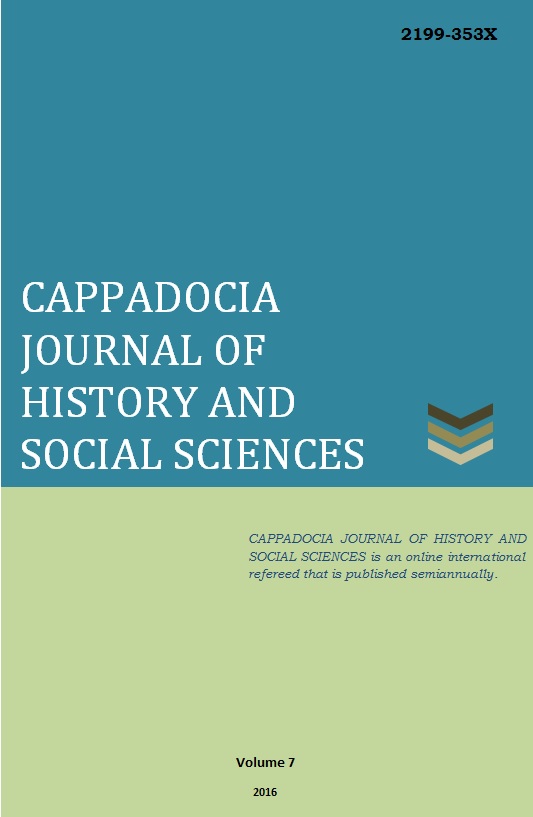Author :
Abstract
Köy odaları, halkın birlikte yaptığı veya köyün zenginleri tarafından yaptırılan, konaklama ve toplanma yeri olmak üzere iki ana görevi olan, mimari özellikler bakımından genellikle yalın binalardır. Köye gelen misafir, tahsildar (devlet görevlileri), yolcu, seyyar satıcı, demirci, kalaycı, nalbant vb. gibi insanların konaklamaları için yapılan köy odaları, Türk Kültürünün önemli özelliklerinden biri olan konukseverliğin somut mekânları olarak karşımıza çıkmaktadır. Köy odalarının ikinci işlevi ise radyo ve televizyon gibi kitle iletişim araçlarının olmadığı dönemde köylünün bir araya gelip sohbet ettiği, bilgi alışverişinde bulunduğu, köyün sorunlarını konuşup tartıştığı ve çeşitli eğlenceler düzenlediği bir meclis görevi görmesidir. Ulaşım sorununun çözülmesi ve teknolojik gelişmelere paralel olarak köy odalarına duyulan ihtiyaç da ortadan kalkmıştır. Bu çalışmada Akseki ilçesinin 41 köy ve 6 beldesindeki arazi çalışması neticesinde tespit edilen 10 adet köy odasının tanıtımı yapılmıştır. Odalardan dokuzu iki katlı, biri ise tek katlıdır. İki katlı olanların genellikle alt katları ahır, üst katları ise oda olarak planlanmıştır. Odaların inşa tekniği boyuna ve dikine ahşap hatıllarla takviyeli moloz taş malzemeli kuru yığma duvardır. Hatılların uçları dışarıya doğru 15-20 cm. taşıntı yaptığı için yöre halkı tarafından düğmeli duvar olarak adlandırılmıştır.
Keywords
Abstract
The village chambers are mostly simple buildings in structural terms built by the villageers or by the rich people of the village in order to meet the needs of accommodation and gathering. Being constructed for the accommodation for such people as guest, tax collector (or government officer in general), traveler, seller, ironmonger, tinsmith, blacksmith and etc., the village chambers can be considered as concrete spaces of hospitality, an indispensable part of Turkish culture. The second function of the village chambers is an assembly-like setting where the villagers would gather and talk each other especially during a period when such any mass communication tools as radio and television not to have been introduced yet, and would try to solve the common problems of the village and hold some entertainting activities altogether. Parallel to the resolution of the problem of transportation and the technological developments, the necessity of village chambers has diminished. This paper introduces ten village chambers determined at the end of a field study covering 41 villages and six towns of Akseki. Nine of the chambers are two-storey, the rest is single storey. Those under the former category are arranged in a way to be barn at downstairs and the chamber itself at the upstairs. Their building technique is masonry wall of rubble stone reinforced with horizontal and vertical wooden balks. Since the ends of these project out 15-20 cm to the outside, they are called düğmeli duvar, that’s buttoned wall, by the local people.
Keywords
- ABDURREZZAK, Ali Osman, Kastamonu Köy Odalarının Sosyal, Kültürel ve Ekonomik İşlevleriÜzerine Bir Araştırma, (Hacettepe Üniversitesi Sos. Bil. Ens. Türk Dili ve Edebiyatı Anabilim Dalı, Türk Halkbilimi Bilim Dalı Yüksek Lisans Tezi), Ankara 2011.
- ADAK, Mustafa, TAKMER, Burak, AKDOĞU ARCA, Ebru N. “İlkçağ’da Akseki Bölgesi”, BenAkseki’yim, (Hazırlayan, Attila Durak), Akseki Eğitim Hayratı Derneği Yayınları, İstanbul 2015, s.250-275.
- ARSLAN, Murat, Değirmenlik Köyü, Lord Matbaacılık ve Kâğıtçılık, İstanbul 2014.
- BOZKURT, Tolga, “Konya-Gökyurt (Kilistra) Köy Odaları”, Milli Folklor, Ankara 2016, S.109, s.201-216.
- BÜYÜKÇANGA, Mehmet, “Osmanlı Döneminden Günümüze Devam Eden Konya İli Kadınhanıİlçesi Meydanlı Köyünde Bulunan Köy Odaları”, Uluslararası Kuruluşunun 700. Yıl Dönümünde Bütün Yönleriyle Osmanlı Devleti Kongresi, Konya 1999, s.719-724.
- ÇAL, Halit, “The Architecture Of Boyabat Village Houses”, The Ottoman House Papers From The Amasya Symposium 24-27 September 1996, Oxford 1998, p.46-53.
- ÇAL, Halit, ÇAL, Özlem, Trakya Bölgesi Kapı Tokmakları ve Çekecekleri, Atatürk Kültür Merkezi Yayınları, Ankara 2008.
- ÇINAR, Kerim, “Konya Ovası Köy Yerleşmelerinde Misafirhaneler (Köy Odası)”, Türk Halk Mimarisi Sempozyumu, 5-7 Mart 1990, Ankara 1991, s.57-71.
- ÇOBANOĞLU, Aysun, “Akseki”, Dünden Bugüne Antalya, Antalya İl Kültür Ve Turizm Yayınları, Antalya 2012, s.245-249.
- ELDEM, Sedat Hakkı, Türk Evi Plan Tipleri, İstanbul 1954.
- ERAVŞAR, Osman, “Akseki ve Çevresindeki Selçuklu İzleri”, Ben Akseki’yim, (Hazırlayan, Attila Durak), Akseki Eğitim Hayratı Derneği Yayınları, İstanbul 2015, s.290-305.
- ERÜNSAL, İsmail, Bir Ahilik Geleneği Köy Odası Hatıraları Molla Musa’nın Konağı, Kırşehir 2013.
- ERÜNSAL, İsmail, Bir Ahilik Geleneği Kırşehir’deki Hanedan Odaları, Ankara 2014. KARPUZ,Haşim, “Konya Köy Odaları’nın Kültür ve Sanat Değeri”, Emin Bilgiç Hatıra Kitabı, İslam Tarih Sanat ve Kültürünü Araştırma Vakfı Yayınları, İstanbul 2000, s.319-361.
- KARPUZ, Haşim, “İç Anadolu Bölgesi Köy Odaları”, XVI. Ortaçağ-Türk Dönemi Kazıları veSanat Tarihi Araştırmaları Sempozyumu Bildirileri, 18-20 Ekim 2012, Cumhuriyet Üniversitesi Yayınları, Sivas 2013a, s.455-471.
- KARPUZ, Haşim, “Kadınhanı’nda Halk Mimarisi”, Prof. Dr. Hakkı Önkal’a Armağan, Dokuz Eylül Üniversitesi Yayınları, İzmir 2013b, s.131-147.
- KARPUZ, Haşim, BOZKURT, Tolga, “Ilgın-Beykonak (Tekke) Köyü’nde Halk Mimarisi”, K.Levent Zoroğlu’na Armağan, Akmed, Suna-İnan Kıraç Akdeniz Mdeniyetleri Araştırma Enstitüsü Yayınları, İstanbul 2013c, s.345-360.
- KAVAS, Kemal Reha, “Akseki-İbradı Havzası’nda Geleneksel Mimarlık”, Ben Akseki’yim,(Hazırlayan, Attila Durak), Akseki Eğitim Hayratı Derneği Yayınları, İstanbul 2015, s.364-389.
- KAVAS, Kemal Reha, “Alanya-İncirkırı Geleneksel Kırsal Mimarisinde Doğa-Kültür İlişkisi”, Zeitschrift für die Welt der Türken, 2011, Vol 3, No 1, p.271-289.
- KAVAS, Kemal Reha, Akdeniz Dağlık Yerleşimindeki Kırsal Mimari Gelenekte Çevre Estetiği:Ürünlü Örneği, (ODTÜ Sosyal Bilimler Enstitüsü, Mimarlık Tarihi Anabilim Dalı Doktora Tezi), Ankara 2009.
- ÖZKAN, Adem, “Köy Odalarının Sosyal Hayatımızdaki Rolü”, İmaret, Karaman 2011, Yıl 2, S.7,ÖZKAN, Adem, “Geçmişten Günümüze Konya İli Akören İlçesinde Bulunan Köy Odaları”,Karamanoğlu Mehmet Bey Üniveristesi Sosyal ve Ekonomik Araştırmalar Dergisi, Karaman 2012, S.14, s.1-4.
- ÖZKAYNAK, Kemal, Akseki Kazası, Tarih-Coğrafya-Turizm-Biyoğrafya, Akgün Matbaası, Ankara 1954.
- ÜNVER, Mustafa, “Müslüman-Türk Anadolu İnsanının Eğitim ve Öğretiminde Köy OdalarınınRolüne Folklorik Bir Bakış”, Ondokuz Mayıs Üniversitesi İlahiyat Fakültesi Dergisi, Samsun 2005, S.18-19, s.71-92.
- YAKICI, Ali, “Somut Olmayan Kültürel Mirasın Somut Mekânı: Konya Barana Odaları”, Milli Folklor, Ankara 2010, S.87, s.94-100.
- YARAR, Sibel, Geleneksel Akseki Evlerinde Tavan Süslemeleri, (Gazi Üniversitesi Sosyal BilimlerEnstitüsü, Arkeoloji ve Sanat Tarihi Anabilim Dalı Sanat Tarihi Bilim Dalı, Yüksek Lisans Tezi),YARAR, Sibel, “Akseki’den Üç Konağın İç Mekân Duvar Süslemeleri”, Ben Akseki’yim,(Hazırlayan, Attila Durak), Akseki Eğitim Hayratı Derneği Yayınları, İstanbul 2015, s.391-401. Antalya Haritası:
- https://upload.wikimedia.org/wikipedia/commons/0/01/Antalya_districts.png Erişim tarihi: 30.12.2015
